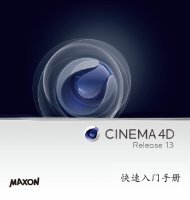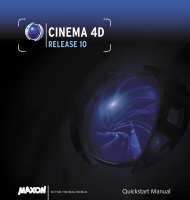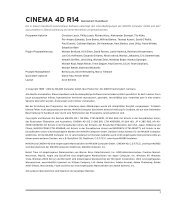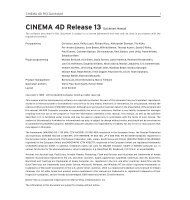Optional module - Maxon Computer
Optional module - Maxon Computer
Optional module - Maxon Computer
Create successful ePaper yourself
Turn your PDF publications into a flip-book with our unique Google optimized e-Paper software.
38 CINEMA 4D R11 Quickstart – Materials<br />
A standard material has been created. If you click on this material its properties will be made visible in the<br />
Attribute Manager to the right. In the “Basic“ menu you can determine which channels should be activated for<br />
this material. Go ahead and activate the Bump channel. As soon as you have done that a new menu button,<br />
“Bump“ will appear. Now click on the menu button “Color“ and load a texture into the material by clicking on<br />
the small arrow next to “Texture“. Choose “Load Image“ and load Iristexture.jpg.<br />
In the mini-preview of the Material Manager at the lower left of your screen you will see the texture displayed<br />
as soon as it has been loaded. This gives you a good overview of the materials being used in the scene.<br />
Repeat this procedure for the “Bump“ channel and load Iristexture_bump.jpg into the channel. This JPEG<br />
contains the gray scale version of the iris texture which we need to create a relief effect for the surface. You can<br />
also choose “Filter“ (click on the small light gray arrow next to the word “Texture” in the Bump channel) and<br />
load the color texture here and set its saturation to 100%. This saves you from having to load a second image.<br />
The bright areas of the image will later appear to be raised on the object and the dark areas of the image will<br />
appear to be somewhat indented. A true deformation of the object will only take place in the “Displacement“<br />
channel. The “Bump“ channel does not alter the polygon’s surface but uses an optical illusion to give the surface<br />
its structure.<br />
Click on the material in the Material Manager with the left mouse button and drag it onto the object eyeball<br />
in the Object Manager. (When you drag the material over the object you can let go once the little black arrow<br />
points down). Alternatively you can drag the material onto the desired object (the eyeball) directly in the Editor.<br />
Just make sure you drop the material onto the correct object if there are several in the scene or in close proximity<br />
to one another. You can check in the Object Manager to make sure the material was dropped onto the correct<br />
object - the material icon will appear next to the object onto which it was dragged.<br />
You have probably noticed that the eyeball brightened somewhat after you applied the material but you aren’t<br />
able to see the actual texture. We still have to change the offset properties and the mapping size so the texture<br />
will be aligned properly on our object. At the moment the actual image of the iris is lying distorted on the left<br />
side of the eyeball. You can check this by making both HyperNURBS eyelid objects invisible for the editor. To do<br />
this double-click on the top small gray dot to the right of the object in the Object Manager (until it turns red).









